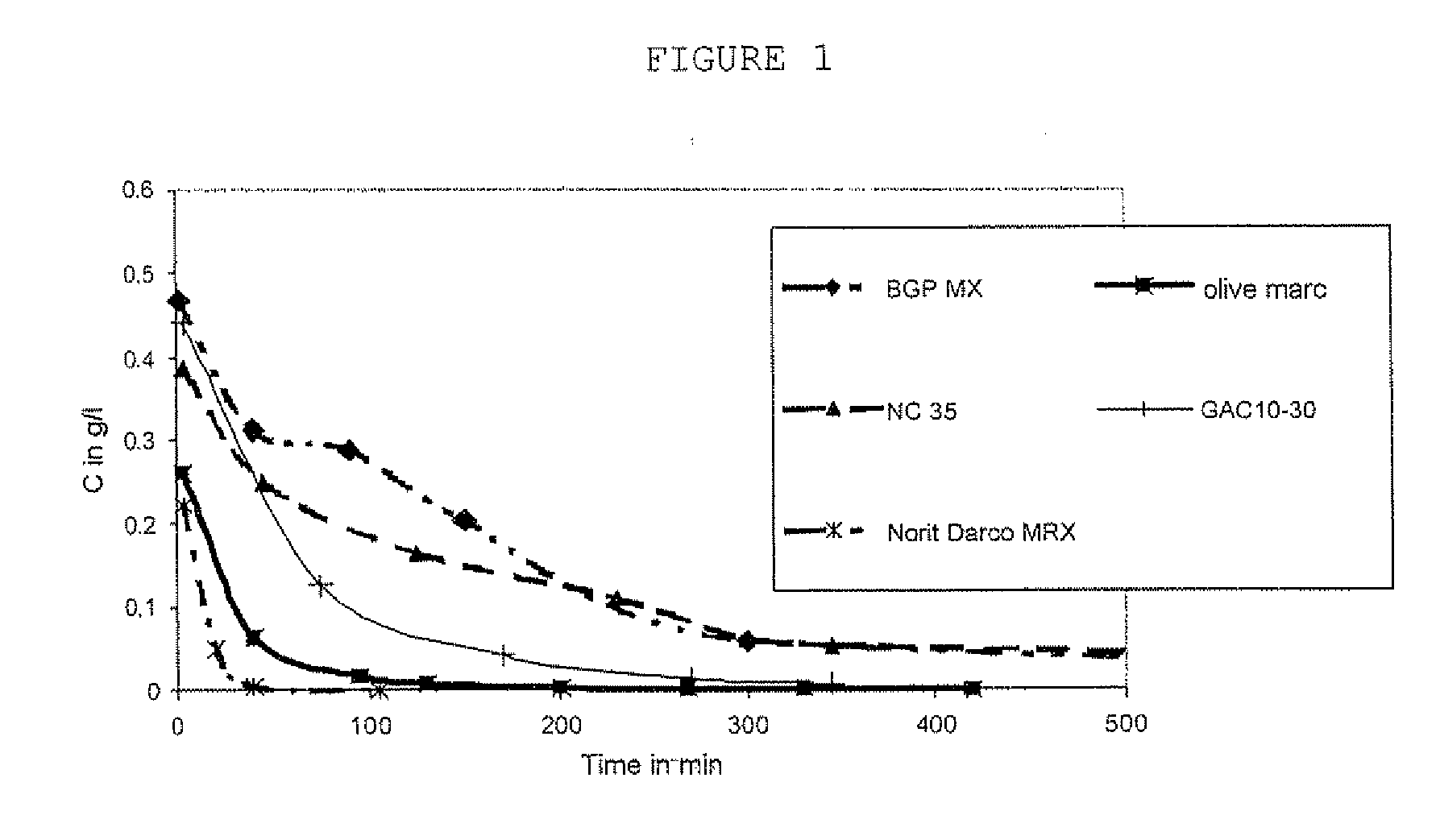Activated carbon with improved mechanical resistance, and the uses thereof, especially as a catalyst carrier
a technology of active carbon and mechanical resistance, which is applied in the field of active charcoal, can solve the problems of increasing the increasing mechanical stress, and damage to active charcoal granules, and achieves the effects of strong mechanical properties, rapid impurity removal, and low content of inorganic impurities
- Summary
- Abstract
- Description
- Claims
- Application Information
AI Technical Summary
Benefits of technology
Problems solved by technology
Method used
Image
Examples
example 2
MPREGNATION KINETICS OF THE CATALYST
[0056]A catalyst solution comprising 30% of sulphonated cobalt phthalocyanine, sold by Europhtal under the name 802, is used.
[0057]320 ml of active charcoal are introduced into 1 litre of water in a beaker. A small amount of ammoniacal solution is added, such that the pH of this final solution after addition of the ammoniacal solution is greater than or equal to 9. A dose of Europhtal 802 catalyst is subsequently introduced such that the final product has a dose of exactly 2 g of catalyst per litre of active charcoal. The mixture is gently stirred and samples are taken spaced out over time. The amount of catalyst still present in the solution is assayed. This assaying can be carried out by an optical density measurement at the wavelength of 660 nm, after precalibration of the apparatus.
[0058]The results are given in the following FIG. 1.
[0059]It is seen that the active charcoal according to the invention based on olive marc and Darco MRX are impre...
example 3
TEST OF OXIDATION OF MERCAPTAN
[0060]This test draws its inspiration from works such as: Oxidation of ethyl mercaptan over cobalt phthalocyanines, Huendorf U. at al., Heterog. Catal., 6(2), 73 (1987).
[0061]0.5 ml of active charcoal, preimpregnated with catalyst according to the test of Example 2 (i.e. 2 g of catalyst / litre of charcoal), 50 ml of sodium hydroxide solution (concentration: 7% by weight) and 140 g of n—heptane comprising 2.81 g of t—butyl mercaptan are successively introduced into a 0.5 litre glass reactor maintained at ambient temperature by a jacket. Stirring adjusted to 500 revolutions / min is begun and an air flow controlled at 1 litre / h is introduced by sparging into the solution.
[0062]Samples of the organic phase are taken spread out over time in order to monitor the residual mercaptan concentration. The mercaptan is assayed by chromatography.
[0063]The initial RSH content is 20 000 ppm by weight.
[0064]The results are given in the following Table 3:
TABLE 3Kinetics of...
PUM
| Property | Measurement | Unit |
|---|---|---|
| size | aaaaa | aaaaa |
| nitrogen adsorption | aaaaa | aaaaa |
| micropore volume | aaaaa | aaaaa |
Abstract
Description
Claims
Application Information
 Login to View More
Login to View More - R&D
- Intellectual Property
- Life Sciences
- Materials
- Tech Scout
- Unparalleled Data Quality
- Higher Quality Content
- 60% Fewer Hallucinations
Browse by: Latest US Patents, China's latest patents, Technical Efficacy Thesaurus, Application Domain, Technology Topic, Popular Technical Reports.
© 2025 PatSnap. All rights reserved.Legal|Privacy policy|Modern Slavery Act Transparency Statement|Sitemap|About US| Contact US: help@patsnap.com

